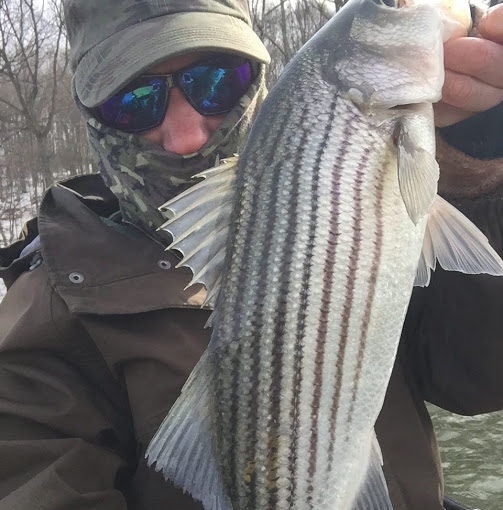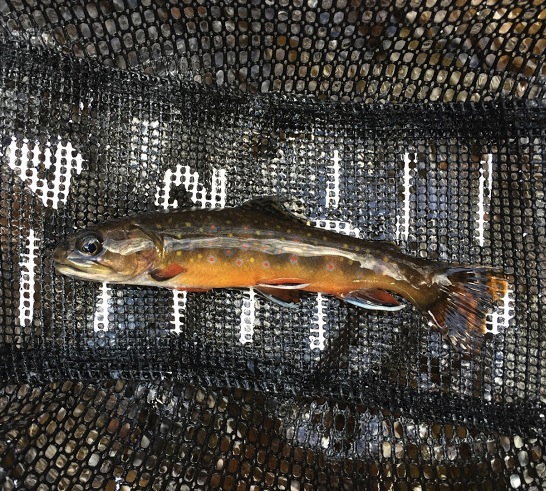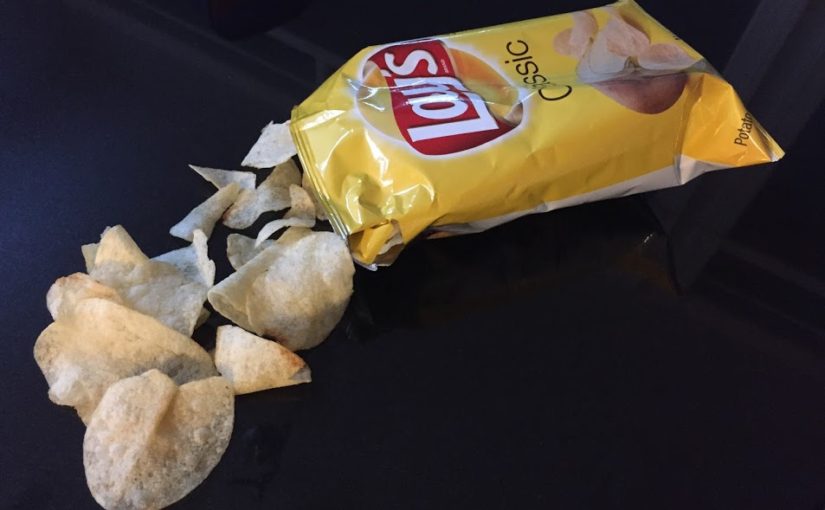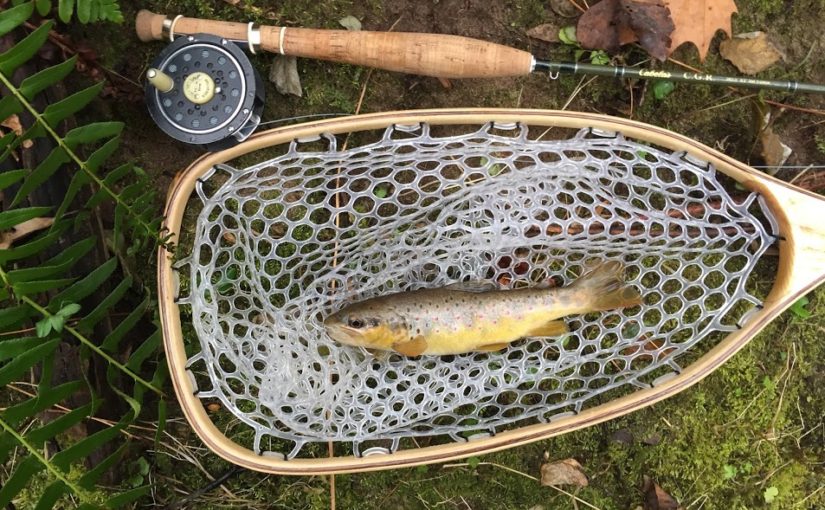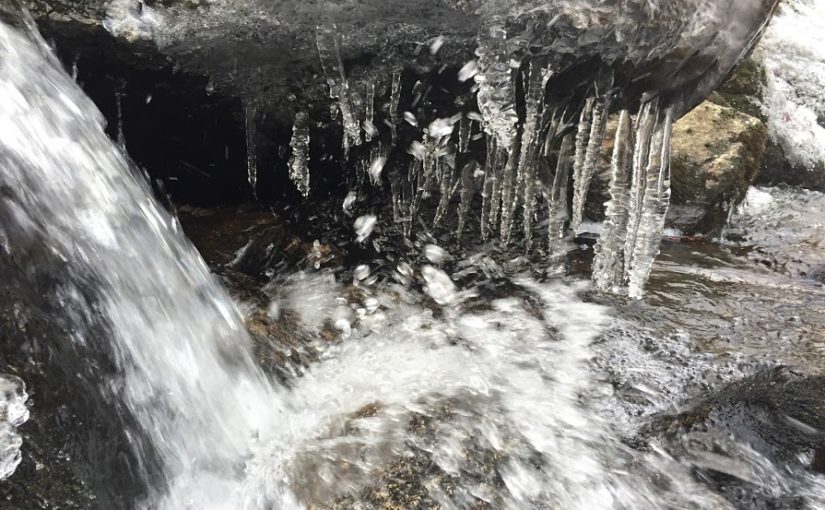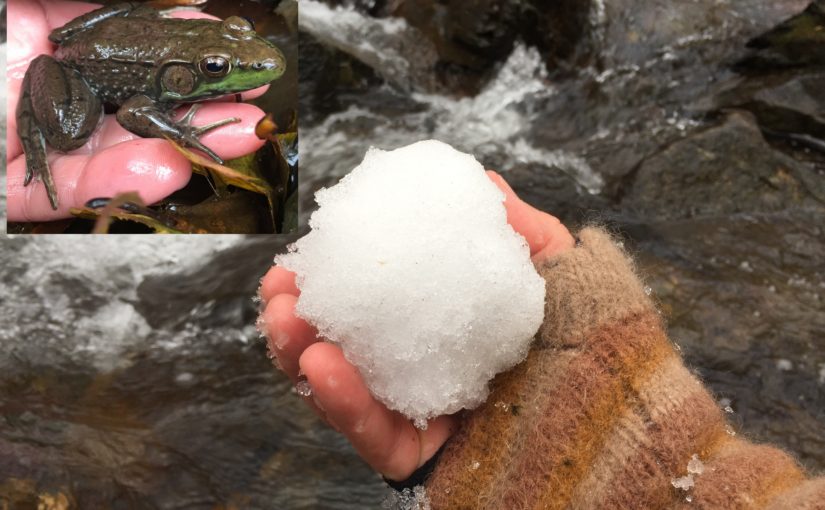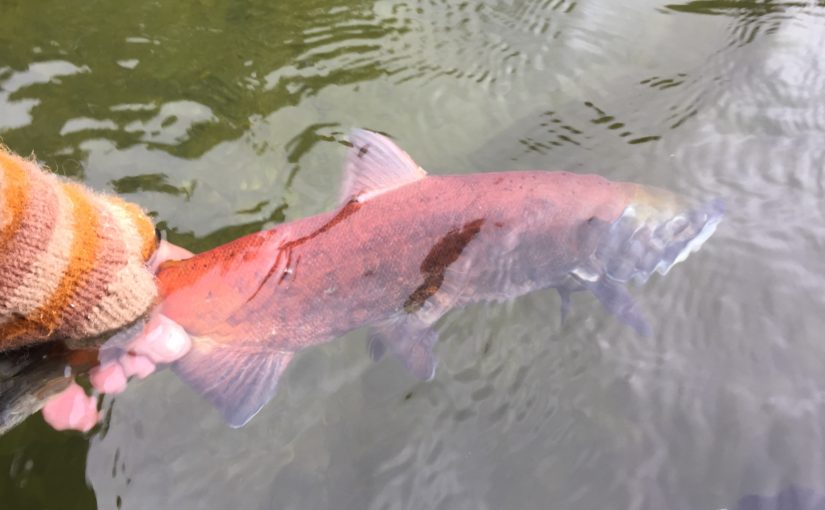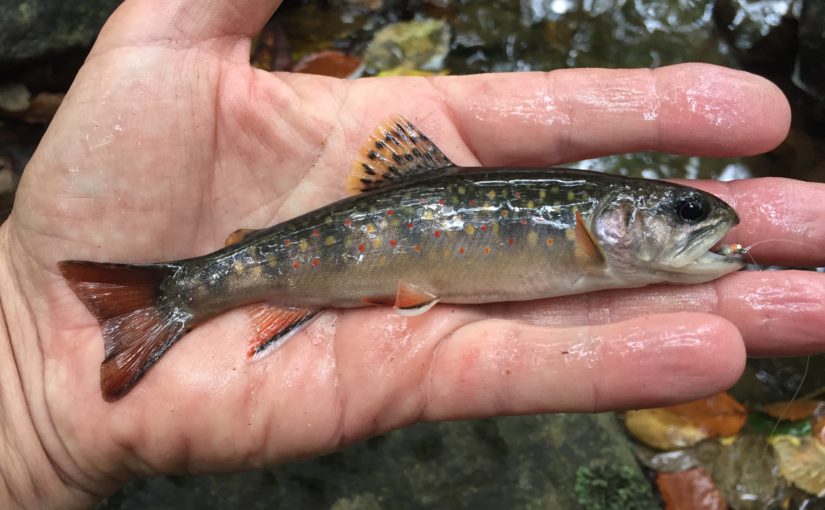Remove your trolling motor prop. Cut and unwrap any fishing line that may have accumulated last season. I’m told, if left in place, this line can reduce efficiency of your motor and even damage seals. You won’t know its there until you check.
Author: FishTekBlog
Cabin Fever Stripers
Snow storms, schedules, and single digit temperatures have kept me off the water for a while. I was in need of some therapeutic fishing time. Small stream trout fishing wasn’t going to do it for me this time. I needed something a little bigger and a little more numerous, so I set off to explore a new option.
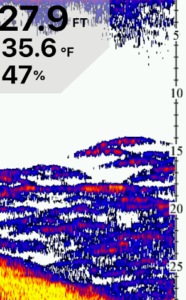
Normally, I’d say it’s too cold for striped bass in February. Over the years, I’ve heard a handful of magic numbers thrown out – 40, 42, 50 degrees. Fill in the blank for what temperature stripers start feeding. The fact is if a fish is alive and healthy, it eats. They might not eat very often or put forth much effort to do it, but they eat. If you find enough of them you’ll get bit, and if you find a lot you just might get bit a lot.
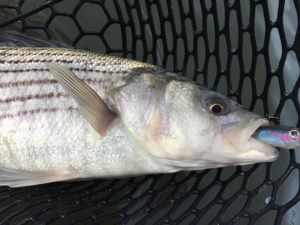
I tried a few different lures, but fell back on an old standby – the Fishbelly Hawg Shad. I switched back and forth between a 5″ and a 3.5″. They both proved effective. Alewife, Blueback Herring, and Common Dace were the colors I fished on this day, and they all caught fish.
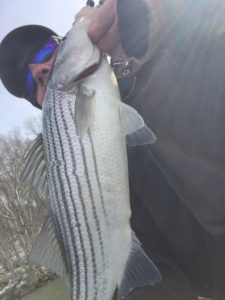
Besides a quality lure like the Hawg Shad, there are three additional keys to success in these frigid conditions. The first and most critical is finding the fish. You can’t catch fish that aren’t there. Fish the best structure on waters that support large populations.
The second is using enough weight to maintain contact with the lure without overweighting the presentation. A little glide is good. Losing touch with your bait is bad.
The third is not over working the bait. Less is more when it comes to winter fishing. Fast, aggressive movements seem to turn these semi-dormant fish off.
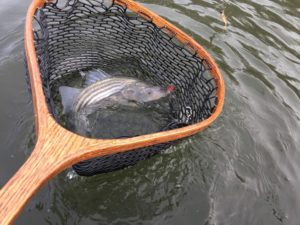
My Northkill custom landing net was an important tool to have onboard. Sure a couple fish were held up for a quick pic, but a couple dozen more were released without ever removing them from the water. The rubber net bag was easy on their slime coat, and single barbless hooks came out easily. Winter is tough enough. Let’s not be any harder on the fish than we have to be.
Oh Yeah, The List
I said I was going to keep the fly fishing species list again in 2019. Let’s see if I can hit 20 species this time. Here’s where it stands through January.
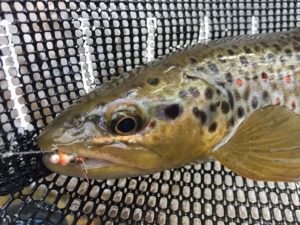
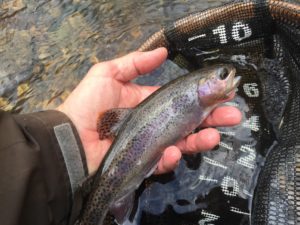
The 2019 Fly Fishing Species List:
- Brook Trout – Salvelinus fontinalis
- Brown Trout – Salmo trutta
- Rainbow Trout – Oncorhynchus mykiss
One Fish, Greed, Potato Chips, and Fishing’s Small Accomplishments
Years ago, I knew a man that worked at a local fly shop. He was a pudgy, gnome-like character; opinionated, and maybe not so well informed. Anyway, he would not strike anyone as the philosophical type – not right off the bat anyway. He told me once that he just needed “one fish”.
This is what he meant by “one fish”. On any given day if he had time to catch one fish, the day was good. After that “one fish” he could recover from or move on to more tedious chores and responsibilities.
That was somewhat puzzling to me. I understood what he was saying, but could not relate to it. To me fish were like potato chips. If I caught one it made me want to catch two, and two made me want three, and so on.
In the last few months I have frequently thought about what my gnome-like friend had said. I am starting to feel that way more and more myself. There are days when one fish is all I need to make the day complete. I’ve always found peace in fishing, but it has really started taking on a zen quality.
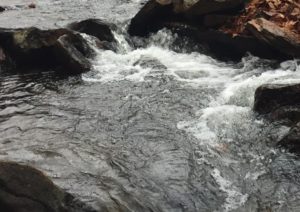
So anyway, the other day I had time for a quick trip for that “one fish”. I chose a local trickle. After a short walk, I began working upstream away from my car. It wasn’t long before one fish ate my fly.
It was a colorful native brookie. It was an exemplary, small stream trout. It could be my “one fish”. There was a bit more to this stretch of stream, so I continued on beyond this one fish. I was content, but not done with the stretch of stream.

A couple of pools upstream, I had another take. An energetic hook set on a short line flung the fish out of the water. I recognized the small fish as a brown trout as it sailed past my shoulder. I tried to keep gentle tension on the line as the fish came down in the water behind me. I wasn’t able to pull it off. The barbless hook came free, and I chuckled to myself at the preceding sequence of events.
The next pool held another hungry fish. This fish had enough body weight to stay put when I set the hook. The head shakes and the bend in my 2 weight identified a solid fish. I worked it out of the depths and into the shallows where I was standing. A foot long brown with big black spots was about to be fish number two, or so I thought.
The trout made one more lunge into the current. It stopped dead for a moment. Something changed. I could see the fish, but the head shakes stopped. The second fly on the tandem rig was snagged on something.
I pulled my net free from the magnetic net holder, and hustled toward the tethered fish. Just as I started to bend toward the trout he shook free of the hook and left me pinned to a trash bag. Oh, the challenges of suburban trout fishing!

This was not followed by any chuckling. This warranted and received a string of expletives, diminishing, but repeated every time I thought about that fish. My satisfying “one fish” from a few minutes ago was no longer so satisfying. I needed a win to make up for that loss. So much for zen.
I was nearing the end of this stretch of stream. Only a couple of pools remained. I blew it on both of them. I hung the fly in shoreline brush and had to walk too close in order the free it. The pools were spoiled. I couldn’t buy a strike. Maybe I was still flustered, or maybe it was just bad luck and a crosswind.
I couldn’t walk away beaten. I hiked downstream, past my starting point, and through the woods. I was going to fish another stretch, working my way back upstream toward my car.
The first few likely looking spots yielded no fish. My muttering self diatribe was starting again. Then I hit paydirt. In about the fishiest looking pool you could imagine I had a take.
Here’s my brown. No wait! It’s a rainbow. I had heard that there were wild rainbows in this stream, but this was the first I had seen myself. I was quite pleased for a moment. Now, here’s where the greed kicks in.
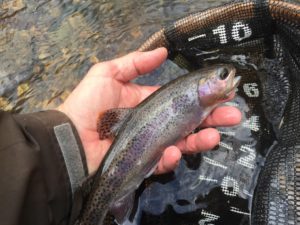
As much as I appreciated catching this beauty of a wild rainbow, it made me crave another potato chip. I had a brook and a rainbow. Now, I needed a brown to complete a slam.
What was that nice fish I lost earlier? Oh yeah, it was brown trout.
The next pool looked as promising as the previous only just a little bigger. Right away I get a take. Here’s my brown. No, it’s not a brown. It’s another rainbow, a beautiful specimen and only the second I have seen in this stream, but not a brown. Talk about conflicting emotions.
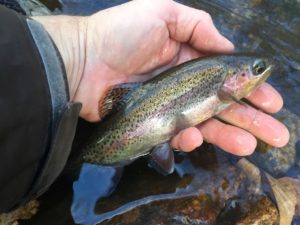
The next hole yields a small brookie. Again, it’s almost a disappointment – almost. The next after that offers another taste of defeat as a diminutive brown trout shakes my hook before I can land it. This is turning into work.
Fast forward through the stream bed, sprinkle in a couple more natives, and another lost brown. Let’s wrap this up. This story is starting to drag.
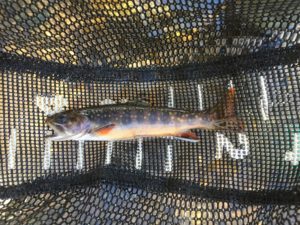
I reached a section with a little different topography. It was a little flatter. There was more sand and wood. There were fewer boulders. I was running out of both time and water.
At the tail of a large flat pool, I see a fish holding just off a log that runs nearly the length of this pool. Like clockwork, the fish takes my fly on the first presentation. As it turns with the fly, I see it is a brown. I pull tight and the fish immediately shakes free and runs under the log. For some reason this one doesn’t bother me. Maybe I’m beaten.
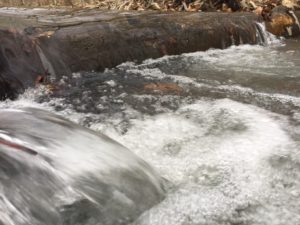
I move a few feet upstream to cast to the head of the pool. The water is flat and crystal clear. I can see everything – almost everything.
I cast above where a fish should be. The fly drifts a couple feet. I see a trout materialize out of nowhere. It turns and I set the hook. It’s a nice one. After a few big head shakes, the fish turns downstream and performs a splashy, wallowing jump. It’s bigger than I thought.
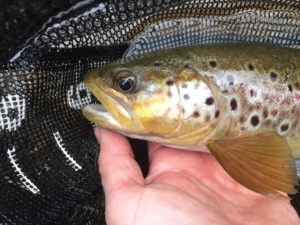

After a crazy tug of war, up the pool, down the pool, under the log a couple times, an absolute beauty of a brown comes to my Northkill net – measuring a smidgeon over 15 inches. That was the fish I needed. It was a big fish for a trickle, a big fish on a 2 weight, a brook-rainbow-brown slam, and compensation for my earlier loss. That was the “one fish” and the last potato chip.
The Fly Fishing List Wrap Up
I set out to catch 20 different species on a fly rod in 2018. Although I fell short of the goal, the fly rod species list was probably more of a success than a failure. It was a little distracting at times, but it got me out on some new waters, and to some degree reunited me with fly fishing. A new year is upon us, and I’m wondering whether I should take another crack at it.
Where “The 2018 Fly Fishing List” ended – just one species shy of the goal:
- Brown Trout – Salmo trutta
- Brook Trout – Salvelinus fontinalis
- Rainbow Trout – Oncorhynchus mykiss
- Landlocked Atlantic Salmon – Salmo salar
- Creek Chub – Semotilus atromaculatus
- Northern Pike – Esox lucius
- Largemouth Bass – Micropterus salmoides
- Chain Pickerel – Esox niger
- Black Crappie – Poxomis nigromaculatis
- Bluegill – Lepomis macrochirus
- Bowfin – Amia calva
- Pumpkinseed – Lepomis gibbosus
- Common Shiner – Luxilus cornutus
- Redbreast Sunfish – Lepomis auritus
- Rock Bass – Ambloplites rupestris
- Green Sunfish – Lepomis cyanellus
- Smallmouth Bass – Micropterus dolomieu
- Blacknose Dace – Rhinichthys obtusus
- Kokanee Salmon – Oncorhynchus nerka
Not bad, but I can’t help think of a few species I could have or should have caught on the fly last year. OK – I just decided now. I am going to take another crack at breaking the 20 species barrier. Check in for updates here on the website in the coming weeks.
Five Reasons to Welcome the Winter Solstice
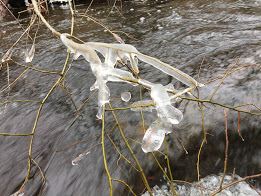


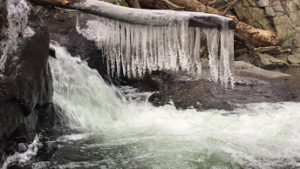

From Frogs to Snowballs
While the salmonid bite remained steady this month, the weather was anything but. Fishing in “shorts weather” to downpours to a snow storm, the conditions ran the gamut as winter draws near. Here are a few November moments.
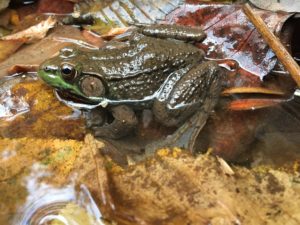
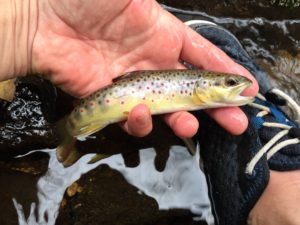
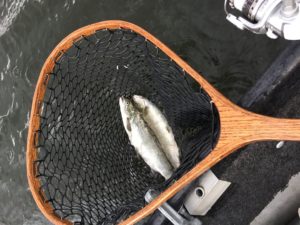
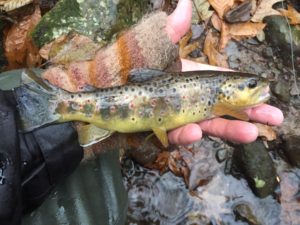
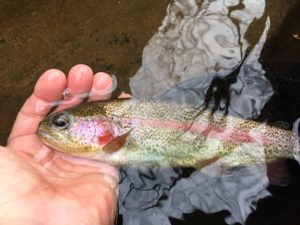

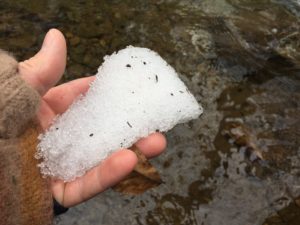
“The 2018 Fly Fishing List” is stalled out at 19. Here’s where is stands so far:
1.Brown Trout – Salmo trutta
2. Brook Trout – Salvelinus fontinalis
3. Rainbow Trout – Oncorhynchus mykiss
4. Landlocked Atlantic Salmon – Salmo salar
5. Creek Chub – Semotilus atromaculatus
6. Northern Pike – Esox lucius
7. Largemouth Bass – Micropterus salmoides
8. Chain Pickerel – Esox niger
9. Black Crappie – Poxomis nigromaculatis
10. Bluegill – Lepomis macrochirus
11. Bowfin – Amia calva
12. Pumpkinseed – Lepomis gibbosus
13. Common Shiner – Luxilus cornutus
14. Redbreast Sunfish – Lepomis auritus
15. Rock Bass – Ambloplites rupestris
16. Green Sunfish – Lepomis cyanellus
17. Smallmouth Bass – Micropterus dolomieu
18. Blacknose Dace – Rhinichthys obtusus
19. Kokanee Salmon – Oncorhynchus nerka
Make Catfish Great Again!
Don’t forget to vote.
Queried Kokanee
Kokanee were a fish I had never caught, yet I had pondered for years. With no waters close by and only a few within a day’s drive, targeting this fish was a proposition full of questions and concerns. Most of these questions would have to be answered on the water, but the first had to be answered just to get the ball rolling.
Where and when to go? My friend and I chose a stocked lake. With little or no natural reproduction in this lake, fishing for spawners would have no impact on a future year class. With ethics out of the way, this would be an autumn trip for sure. We were not interested in eating them, so the condition of the meat was not a factor. The sight fishing aspect and spawning colors are awesome.
The next question was more of a concern. Would we catch anything if this kokanee thing was a bust? We were heading into unknown waters – quite literally. Neither of us had fished anywhere near this lake before. Fishing is never a lock. Some pre-trip research on the fishing options in that area allowed us to drive through the night and arrive at dawn with confidence high.
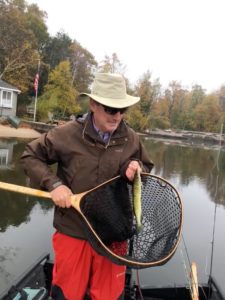
Would we succeed in catching a kokanee? Hell yeah, we did! It did not take us long to locate fish. Once we found them, we were on the salmon board within minutes.

The next question: do they actually bite the fly or are we just “flossing”? They are filter feeders, after all. Add in the fact that they cease feeding when their focus turns to spawning. I had some doubt. I was going to have to see it myself.
The answer was as clear as the water. They didn’t hit every cast. In fact, they didn’t hit the majority of the presentations. When they did bite, it was obvious that they meant it. Whether it was predatory reflex or protecting their redds or whatever, they absolutely did strike our offerings.

Questioning success: what do we do if we drive all this way and catch what we were looking for as soon as we start? Do we hammer the same nail all day? Do we call it early and jump right back in the car?
As it turned out, we started with lemonade, it turned to lemons, and we turned it back into lemonade. We met our primary goals early, so when some jackass in an inflatable boat intolerably crowded our spot, we didn’t react negatively. We took this as a sign to move on and finish exploring the lake.
We broke out the Northkill Tackle spinning rods for efficiency, and covered some water. We found a solid population of brown and rainbow trout willing to take our lures. The trout would have been an acceptable safety net had the kokanee not come through. Nice to know for the future.
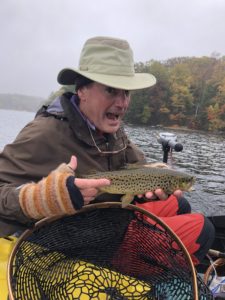
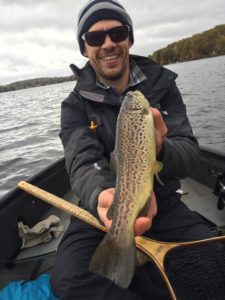
Questioning some details: would any of my “go to” spinning tactics appeal to kokanee? Based on our morning observations, most would have fallen short. Brightly colored 2.8″ Hawg Shads did seem like a promising lure choice – and they were. The kokanee hit them quite well. Hawg Shads never cease to amaze me with their multi-species versatility.

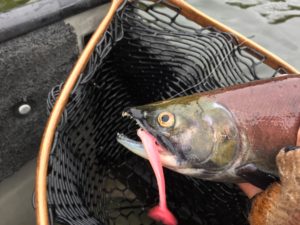
Just how long was this day going to be? We assumed from the start it was going to be a long one. Logistics made that obvious. We had success on multiple species with multiple techniques under our belts. We fished kokanee, we fished trout, back to more kokes, and don’t forget that bonus chain pickerel; we left at the end of a very full day.
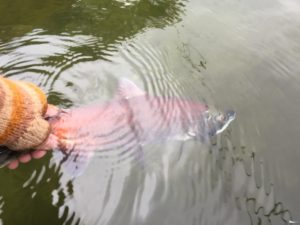
“The 2018 Fly Fishing List” so far:
- Brown Trout – Salmo trutta
- Brook Trout – Salvelinus fontinalis
- Rainbow Trout – Oncorhynchus mykiss
- Landlocked Atlantic Salmon – Salmo salar
- Creek Chub – Semotilus atromaculatus
- Northern Pike – Esox lucius
- Largemouth Bass – Micropterus salmoides
- Chain Pickerel – Esox niger
- Black Crappie – Poxomis nigromaculatis
- Bluegill – Lepomis macrochirus
- Bowfin – Amia calva
- Pumpkinseed – Lepomis gibbosus
- Common Shiner – Luxilus cornutus
- Redbreast Sunfish – Lepomis auritus
- Rock Bass – Ambloplites rupestris
- Green Sunfish – Lepomis cyanellus
- Smallmouth Bass – Micropterus dolomieu
- Blacknose Dace – Rhinichthys obtusus
- Kokanee Salmon – Oncorhynchus nerka
A Visit to a Brook Trout Stream…
…brought a smattering of diminutive Salvelinus fontinalis.
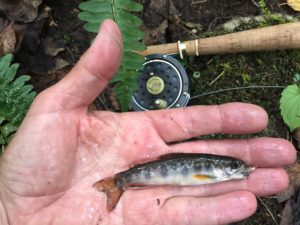
The surprise guest was this blacknose dace. It became #18 on the flyfishing list.
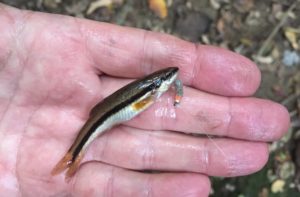
A bonus pumpkinseed from an adjacent pond added some more color to the day.
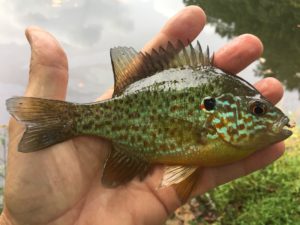
“The 2018 Fly Fishing List” so far:
- Brown Trout – Salmo trutta
- Brook Trout – Salvelinus fontinalis
- Rainbow Trout – Oncorhynchus mykiss
- Landlocked Atlantic Salmon – Salmo salar
- Creek Chub – Semotilus atromaculatus
- Northern Pike – Esox lucius
- Largemouth Bass – Micropterus salmoides
- Chain Pickerel – Esox niger
- Black Crappie – Poxomis nigromaculatis
- Bluegill – Lepomis macrochirus
- Bowfin – Amia calva
- Pumpkinseed – Lepomis gibbosus
- Common Shiner – Luxilus cornutus
- Redbreast Sunfish – Lepomis auritus
- Rock Bass – Ambloplites rupestris
- Green Sunfish – Lepomis cyanellus
- Smallmouth Bass – Micropterus dolomieu
- Blacknose Dace – Rhinichthys obtusus

